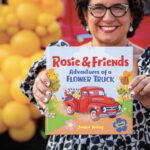 Adopting a dog from Mastiffs to Mutts is not as simple as asking, “How much is that doggie in the window?”
Adopting a dog from Mastiffs to Mutts is not as simple as asking, “How much is that doggie in the window?”
Mastiffs to Mutts is an all-volunteer organization committed to placing mastiffs and other giant-breed dogs with families who will commit to them.
“You’re not just adopting a big dog, you’re adding a really large member to your family,” said Peg Benoit, president of the non-profit, which is based in Chambersburg.
Why large-breed dogs?
“Because many rescues only take small- and medium-breed dogs,” said Benoit. “Giant-breed dogs have special considerations. They cost more to feed and medicate than small dogs. And with groomers and boarders charging by the pound, it’s critical that adopters know the expenses they’re accepting responsibility for.”
Giant-breed dogs weigh 100 to 280 pounds, are 23 to 38 inches high, and cost upwards of $124 per month for food and flea/heartworm preventative medicine. They may need basic training, but they definitely need to continue to socialize with people and animals to prevent them from becoming overprotective.
Large dogs do not necessarily need a large, fenced yard, but they do need daily exercise to suit the individual dog’s need. For example, a senior English mastiff may simply need a daily walk around the block. A younger cane corso mastiff (Italian mastiff) may need several long walks per day or a good session of more vigorous activity.
No matter which giant breed you adopt, the dog needs to be kept indoors. Any dog that is isolated and tied outside can become aggressive. Dogs thrive when they spend time with their people, as they consider their family to be part of their pack.
What to Expect
Not just anyone is allowed to adopt a giant dog from Mastiffs to Mutts.
Each adoptive family is thoroughly researched prior to placement, as are the foster families who open their homes to the dogs temporarily. A volunteer will inspect the potential home for safety and pet-friendliness. The careful screening process involves background checks and proof of homeownership.
Volunteer investigators also verify from local shelters and pounds that the applicant hasn’t relinquished animals to them and that there is no record of “dogs at large” or similar violations. They also talk to the person’s references, veterinarian and neighbors.
“You can find out a lot of information from neighbors,” said Benoit. “It’s amazing what they’ll tell you. If an owner is away for weeks at a time or their current dogs are already constantly barking, that’s not a good sign. It’s important to know what kind of people want one of our dogs.”
Applicants who have previous experience with giant breeds is a positive, said Benoit.
“They already know what to expect and how to accommodate,” she said. “It speaks well of an applicant if their vet knows their name without looking at their records. It’s likely they have an ongoing relationship with that vet office.”
The Mastiffs to Mutts adoption committee reviews each adoption application and the details of each investigation. On the list of applicants ineligible for placement are minors, families with children under 6 years of age, renters and residents outside the mid-Atlantic area.
“If the committee believes, for any reason, that the dog would not be served by that family or individual, we deny approval,” said Benoit.
With a low 2-percent return rate, the process used at Mastiffs to Mutts has proven itself to be effective, she said.
Adoptive families pay $150 to $500 in adoption fees. All fees collected and donations accepted are reinvested into rescuing more dogs. Each dog receives food, preventative medicine and medical care (which includes spaying or neutering).
The rescue also regularly purchases bedding, toys, collars, leashes and crates. Some funding goes toward fostering and kenneling if no fosters are available. Other funding is used for more severe medical issues such as orthopedic surgeries, heartworm treatment, medical X-rays and diagnostic testing.
Both adopters and foster families will experience growth in their human families as a result of their new additions, said Benoit. Mastiffs to Mutts makes its wide network of pet support available: veterinarians, trainers, classes, pet-sitters, behavioral experts and other resources.
Together, the Mastiffs to Mutts network helps to make the placement successful and the transition as smooth as possible. Trainers volunteer countless hours via email and telephone to work with families whose dogs have behavioral issues.
“Dog people stick together,” said Benoit. “Rescuers, animal control—we all work together for the best interests of the dog. We’re available during and after the adoption to help the families and give guidance.”
If you think you have what it takes to add a giant-breed dog to your family, check out www.mastiffstomutts.com. You can view profiles and pictures of dogs eligible for adoption. You can also donate funds online. For additional information, you also can email mastiffstomutts@gmail.com.





